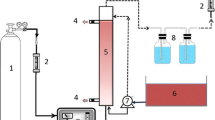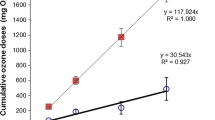Abstract
Pigments in molasses wastewater (MWW) effluent, such as melanoidins, were considered as kinds of the most recalcitrant and hazardous colorant contaminants to the environment. In this study, de-coloring the MWW by a synergistic combination of micro-electrolysis with bio-treatment was performed. Aiming to a high de-colorization yield, levels of nutrition source supplies, MWW dilution ratio, and micro-electrolysis reaction time were optimized accordingly. For a diluted (50 %, v/v) MWW, an maximum overall de-colorization yield (97.1 ± 0.5 %, for absorbance at 475 nm) was achieved through the bio-electrolysis treatment. In electrolysis bio-treatment, the positive effect of micro-electrolysis was also revealed by a promoted growth of fungal biomass as well as activities of ligninolytic enzymes. Activities of lignin peroxidase, manganese peroxidase, and laccase were promoted by 111.2, 103.9, and 7.7 %, respectively. This study also implied that the bio-treatment and the micro-electrolysis had different efficiencies on removal of pigments with distinct polarities.






Similar content being viewed by others
References
Ganesh R, Rajinikanth R (2010) Anaerobic treatment of winery wastewater in fixed bed reactors. Bioproc Biosyst Eng 33:619–628
Pant D, Adholeya A (2007) Biological approaches for treatment of distillery wastewater: a review. Bioresour Technol 98:2321–2334
Satyawali Y, Balakrishnan M (2008) Wastewater treatment in molasses-based alcohol distilleries for COD and color removal: a review. J Environ Manag 86:481–497
Arimi MM, Zhang Y (2014) Antimicrobial colorants in molasses distillery wastewater and their removal technologies. Int Biodeter Biodegr 87:34–43
Fan L, Nguyen T (2011) Characterisation of the impact of coagulation and anaerobic bio-treatment on the removal of chromophores from molasses wastewater. Water Res 45:3933–3940
Yadav S, Chandra R (2011) Characterization of potential MnP producing bacteria and its metabolic products during decolourisation of synthetic melanoidins due to biostimulatory effect of d-xylose at stationary phase. Process Biochem 46:1774–1784
Sirianuntapiboon S, Zohsalam P (2004) De-colorization of molasses wastewater by Citeromyces sp. WR-43-6. Process Biochem 39:917–924
González T, Terrón MC, Yagüe S, Zapico E, Galletti GC, González AE (2000) Pyrolysis/gas chromatography/mass spectrometry monitoring of fungal- biotreated distillery wastewater using Trametes sp. I-62 (CECT 20197). Rapid Commun Mass Spectrom 14:1417–1424
Dhillon GS, Brar SK (2011) Bioproduction of hydrolytic enzymes using apple pomace waste by A. Niger: applications in biocontrol formulations and hydrolysis of chitin/chitosan. Bioproc Biosyst Eng 34:1017–1026
Abrunhosa L, Oliveira F (2013) Lipase production by Aspergillus ibericus using olive mill wastewater. Bioproc Biosyst Eng 36:285–291
Chavan MN, Dandi ND (2013) Bio-treatment of melanoidin-containing distillery spent wash effluent by free and immobilized Aspergillus oryzae MTCC 7691. Water Air Soil Pollut 224:1–10
Shayegan J, Pazouki M (2005) Continuous de-colorization of anaerobically digested distillery wastewater. Process Biochem 40:1323–1329
Ying D, Peng J (2012) Treatment of mature landfill leachate by internal micro-electrolysis integrated with coagulation: a comparative study on a novel sequencing batch reactor based on zero valent iron. J Hazard Mater 229–230:426–433
Zhu Q, Guo S (2014) Stability of Fe–C micro-electrolysis and biological process in treating ultra-high concentration organic wastewater. Chem Eng J 255:535–540
Cheng H, Xu W (2007) Pre-treatment of wastewater from triazine manufacturing by coagulation, electrolysis, and internal microelectrolysis. J Hazard Mater 146:385–392
Shi Y, Liu H (2009) Mechanism on impact of internal-electrolysis pre-treatment on biodegradability of yeast wastewater. Chin Sci Bull 54:2124–2130
Ruan X, Liu M (2010) Degradation and de-colorization of reactive red X-3B aqueous solution by ozone integrated with internal micro-electrolysis. Sep Purif Technol 74:195–201
Ong S, Toorisaka E, Hirata M, Hano T (2008) Combination of adsorption and biodegradation processes for textile effluent treatment using a granular activated carbon-bioflm confgured packed column system. J Environ Sci 20:952–956
Wang L, Yao Y, Zhang Z, Sun L, Lu W, Chen W, Chen H (2014) Activated carbon fibers as an excellent partner of Fenton catalyst for dyes decolorization by combination of adsorption and oxidation. Chem Eng J 251:348–354
Imran B, Khan SJ, Qazi IA, Arshad M (2016) Removal and recovery of sodium hydroxide (NaOH) from industrial wastewater by two-stage diffusion dialysis (DD) and electrodialysis (ED) processes. Desalin Water Treat 57:7926–7932
Ntampou X, Zouboulis AI, Samaras P (2006) Appropriate combination of physico-chemical methods (coagulation/flocculation and ozonation) for the efficient treatment of landfill leachates. Chemosphere 62:722–730
Lo TC, Chang CA (2011) Correlation evaluation of antioxidant properties on the monosaccharide components and glycosyl linkages of polysaccharide with different measuring methods. Carbohydr Polym 86:320–327
Pant D, Adholeya A (2007) Enhanced production of ligninolytic enzymes and de-colorization of molasses distillery wastewater by fungi under solid-state fermentation. Biodegradation 18:647–659
Patil PU, Kapadnis BP (2003) Decolorisation of synthetic melanoidin and biogas effluent by immobilised fungal isolate of Aspergillus niger UM2. Int Sugar J 105(8):10–13
Miranda MP, Benito GG (1996) Color elimination from molasses wastewater by Aspergillus niger. Bioresour Technol 57:229–235
Mikiashvili N, Wasser SP (2006) Effects of carbon and nitrogen sources on Pleurotus ostreatus ligninolytic enzyme activity. World J Microbiol Biotechnol 22:999–1002
Ohmomo S, Kainuma M (1988) Adsorption of Melanoidin to the Mycelia of Aspergillus oryzae Y-2-32 (Microbiology & Fermentation Industry). Agric Biol Chem 52:381–386
Zhang X, Dong W et al (2014) Degradation efficiency and mechanism of azo dye RR2 by a novel ozone aerated internal micro-electrolysis filter. J Hazard Mater 276:77–87
Zhou H, Lv P (2013) Identification of degradation products of ionic liquids in an ultrasound assisted zero-valent iron activated carbon micro-electrolysis system and their degradation mechanism. Water Res 47:3514–3522
Zhou X, Liu H, Wang YX (2006) Internal electrolysis treatment of yeast-producing wastewater (in Chinese). Environ Sci Technol 29:69–71
Do JY, Salunkhe DK (1975) Water quality: food processing and health. Crit Rev Food Sci Nutr 5:281–298
Moilanen U, Winquist E (2015) Production of manganese peroxidase and laccase in a solid-state bioreactor and modeling of enzyme production kinetics. Bioproc Biosyst Eng 38:57–68
Hadibarata T, Nor NM (2014) De-colorization and degradation mechanism of Amaranth by Polyporus sp. S133. Bioproc Biosyst Eng 37:1879–1885
Yoshio Watanabe RSY (1982) Enzymatic de-colorization of Melanoidin sp. No. 20. Agric Biol Chem 6:1623–1630
Ergul FE, Sargin S (2009) Dephenolisation of olive mill wastewater using adapted Trametes versicolor. Int Biodeter Biodegr 63:1–6
Asses N, Ayed L (2009) Biodegradation of different molecular-mass polyphenols derived from olive mill wastewaters by Geotrichum candidum. Int Biodeter Biodegr 63:407–413
Vahabzadeh F, Mehranian M (2004) Color removal ability of Phanerochaete chrysosporium in relation to lignin peroxidase and manganese peroxidase produced in molasses wastewater. World J Microbiol Biotechnol 20:859–864
Yadav S, Chandra R (2012) Biodegradation of organic compounds of molasses melanoidin (MM) from biomethanated distillery spent wash (BMDS) during the decolourisation by a potential bacterial consortium. Biodegradation 23:609–620
Bharagava RN, Chandra R (2009) Isolation and characterization of aerobic bacteria capable of the degradation of synthetic and natural melanoidins from distillery effluent. World J Microbiol Biotechnol 25:737–744
Acknowledgments
The authors acknowledge the financial support from National Natural Science Foundation of China (Grant Numbers: 51338010, 21107125 and 51221892).
Author information
Authors and Affiliations
Corresponding author
Ethics declarations
Conflict of interest
The authors declare that they have no conflict of Interest in the research.
Additional information
X. Tian co-first author.
Rights and permissions
About this article
Cite this article
Chen, B., Tian, X., Yu, L. et al. Removal of pigments from molasses wastewater by combining micro-electrolysis with biological treatment method. Bioprocess Biosyst Eng 39, 1867–1875 (2016). https://doi.org/10.1007/s00449-016-1661-2
Received:
Accepted:
Published:
Issue Date:
DOI: https://doi.org/10.1007/s00449-016-1661-2




